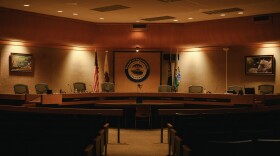Officials at one of the county’s most respected school districts promised to pay back its Mello-Roos accounts after inewsource found it was spending the special tax dollars to pay a consultant to help sell land it owns outside the Mello-Roos area.
The consultant has been billing the Poway Unified School District $150 an hour to evaluate land in Rancho Bernardo, meet with potential buyers and “review offers” months before the school district decided it didn’t need the property and more than a year before it decided to sell it.
Why the consultant was meeting with potential buyers before the school board voted to sell the vacant land and why he was being paid with funds designated for infrastructure-related costs in new developments has been the subject of inewsource’s latest investigation into Mello-Roos spending in the district.
The probe, based on documents, invoices and recorded interviews, uncovered a trail of contradictions about how the district obtained the property and why it’s using Mello-Roos taxes to try and sell it. A timeline of the consultant’s invoices shows he billed for 35 different meetings, phone calls and other work related to the Rancho Bernardo property before the school board began the public process of determining whether it wanted to sell the land.
Poway school Trustee Kimberley Beatty, who was elected to the board a year ago, is the only board member to publicly challenge Mello-Roos spending.
“It seems a clear violation of board policy,” she said after inewsource showed her the consultant’s invoices.
“For lack of a better word, this sort of corrupts the process,” Beatty said about the meetings with developers before the board officially declared the land “surplus.”
District officials say the consultant was hired to do what’s best for the district: determine the value of the land. And, they said, they’ll reimburse the Mello-Roos accounts once the land is sold.
Special Taxes Pay The Bills
Mello-Roos is a special tax added to some property tax bills. One in 10 San Diego homeowners pay the extra tax every year in exchange for the promise of new roads, schools and other infrastructure. It can range from less than a $100 to many thousands of dollars.
A year-long inewsource investigation into the special taxes published last month found Mello-Roos to be a lucrative source of revenue for the Poway district, which collected more than $40 million last year. The rules forming these taxing districts, known as Community Facilities Districts, or CFDs, can be vague, leaving a door open for school districts and other governments to pay for intangible expenses. There is no state oversight of the funds.
inewsource took a close look at contracts and invoices that document the district’s relationship with real estate consultant Joe Taylor. He was hired in 2010 to review the condition of four of the district’s vacant properties, develop a plan for the best use of the land and identify potential buyers or partners, among other things.
Since then, Taylor has billed the district about $150,000 for meetings with dozens of people and groups, including several churches, a lobbying and public relations firm, the grandson of Chargers owner Alex Spanos, a company that builds assisted living facilities and officials in the San Diego mayor’s office, according to a review of his invoices.
Three of the properties Taylor is working on are in Mello-Roos districts. The one in Rancho Bernardo, known as the water tower property, is not.
The district’s contract with Taylor raises two questions: Is it appropriate for him to be paid with Mello-Roos taxes? Did his work sidestep the public process for selling land?
In order to sell land, districts must follow a legal process to determine whether it is needed.
It must form an advisory committee, hold public meetings and eventually make recommendations to the school board about whether the land will be needed for new schools or other district uses.
Taylor helped to form the Real Property Advisory Committee which held two public meetings in March 2012, at which no one showed up.
The committee’s final report to the school board recommended all four sites be declared surplus.
But by the time the committee released that report, Taylor had already spent months meeting with developers and reviewing bids and letters of intent to purchase the properties.
A year before the report, according to invoices, Taylor met with “Monger Group on taking sites to vote” and to “go over campaign plan.” The Monger Company is a Coronado-based lobbying and public relations firm. Among its clients is Santaluz LLC, a firm Taylor is helping with an assisted living project.
Years of state cutbacks have left districts short on cash, many laying off teachers and increasing class size.
Selling property could help close that gap thanks to a new state law that allows a school district to put the profits from surplus property sales into its operational budget, until 2016.
Beatty is worried if the district doesn’t follow the rules it could sell valuable land to balance its budget rather than do what’s best for students in the long term, which could be retain the land for future use.
“The procedure could be tainted and then you wonder if the conclusion was formed before the process actually took its course,” she said.
At least two other trustees disagree. They said hiring Taylor was doing due diligence.
Board president Marc Davis said Taylor was doing market research which was “very valuable.” It was ultimately the advisory committee which recommended the land be considered surplus, not Taylor, he said.
Board vice president Todd Gutschow also said the district had long been interested in leveraging the value of its Rancho Bernardo property.
“I think that’s just good business practice to periodically go out and try to determine if there’s value in the assets that we have,” Gutschow said.
But when it comes to using Mello-Roos taxes to finance Taylor’s work, the answers were not straightforward.
A series of interviews produced one answer one day, another on another day.
Whether paying Taylor with Mello-Roos money is permitted or not, district officials assure: If it’s not appropriate, they will reimburse those special tax funds from the general operating fund.
“What I know is going to happen is when the water tower property is sold the proceeds of that sale will reimburse all of the CFDs that Joe Taylor has been paid from cause until then I don’t have money to reimburse those funds,” Gutschow said.
Controversial Prime Property
The water tower property is nearly 11 acres of prime real estate in Rancho Bernardo and valued at more than $6 million.
The fate of the land has been a subject of debate for years. It’s nestled between tract homes, many built decades ago.
The land is the “biggest thing we have left. Every developer would want it,” David Santistevan, one of the developers Taylor met with about the property, said.
Developers like Santistevan would like to build homes, but community members said they need more park and recreation space.
George Leitner, who has lived about half a mile from the property for 20 years, has been a vocal supporter of building a park at the site. The district paid Taylor to either call or meet with him 10 times according to invoices.
“There was no secret where he was coming from,” Leitner said. “He (Taylor) was commissioned to get maximum speed and money back to the school district, but I guess he came across to me anyway willing to discuss it in a more open-ended way.”
Last month, Poway superintendent John Collins said the district was using Mello-Roos taxes to pay Taylor for his work on the water tower site because Mello-Roos is the district’s biggest funding mechanism. He said expenses associated with that work are reimbursed from the operating budget every year.
“At the end of the year we always do a reimbursement from the general fund for any expenses that were really not tied to the CFDs,” he said.
inewsource filed a request under the Public Records Act for any documents showing the Mello-Roos accounts had been reimbursed for Taylor’s work. The district responded that there were no documents.
In an interview with Trustee Gutschow three weeks later, he said the water tower site had “an association” with Poway’s first Mello-Roos neighborhood.
“All of the properties that Joe Taylor is looking at are Mello-Roos or Mello-Roos-associated properties, and so in that context, it’s appropriate to use Mello-Roos dollars for his work,” Gutschow said.
In a follow-up email, Gutschow also explained Collins was not aware until later the property had a connection to a Mello-Roos district.
“The staff of our planning department was well aware of these details and was coding Mr. Taylor’s invoices accordingly,” Gutschow wrote.
Again, inewsource followed the paper trail, requesting documentation. That led to a contract between a developer and the school district in 1984, three years before the district formed its first Mello-Roos neighborhood.
There was no documented connection between the water tower site and a Mello-Roos neighborhood.
The day inewsource received the 1984 contract, Gutschow emailed to say he had “learned some facts that are different” than what he had provided before.
In another interview, Gutschow said the origin of the property goes back 30 years and he made a mistake when he said earlier the water tower property was associated with a Mello-Roos district.
He said the Mello-Roos accounts would be reimbursed, but not until the water tower property is sold.
“I am not prepared to take money out of general fund and take money away from teachers and the classroom to fund Joe’s (Taylor) work in trying to maximize the value of surplus property for taxpayers in my district,” Gutschow said.
Beatty said the district has a legal obligation to tell taxpayers what their Mello-Roos dollars are paying for.
“Homeowners … have a legal right to know how their money is being spent and if their money is being borrowed that should be disclosed,” she said.
Beatty has been asking questions for months about the legal uses of Mello-Roos funds. She has in the past voted against spending the special tax dollars to fix or upgrade schools in non-Mello-Roos neighborhoods.
The Who’s Who Of Development
Taylor’s invoices shed light on who might be interested in buying the water tower site and the other three properties the school district owns.
They consist of about 10 acres in Torrey Highlands, 11 acres in Santa Fe Valley and 27 acres in Santaluz, according to the district’s website. These three are within Mello-Roos districts.
Taylor reviewed offers and letters of intent to purchase the water tower site from at least five groups, including William “Billy” Shields of Fountain Square Development West, a limited liability company registered in Virginia that builds assisted living facilities.
Taylor also gave tours or discussed purchasing the water tower land and other district properties with more than two dozen people and groups, including Dimitri Economou, who is Alex Spanos’ grandson and works for the A.G. Spanos Companies, which builds homes, master planned communities and commercial buildings.
The invoices also suggest the Church of Jesus Christ of Latter-day Saints might be interested in buying some of the district’s land. Taylor’s invoice states he was following up on “LDS, private school offers.” (LDS is a common abbreviation for the Mormon church.)
Leitner, who still holds out hope that he’ll see a park on the water tower property, believes Joe Taylor’s meetings have been worthwhile. He may finally have brokered a compromise between the community and a potential developer.
“I view the meetings with him and the meetings with others in the community as progressive to getting something done here,” Leitner said.
The school district is now officially accepting bids on the property. The other three properties, while declared surplus by the school board, are not for sale.
Taylor’s contract with the district is scheduled to end June 30, 2015.






